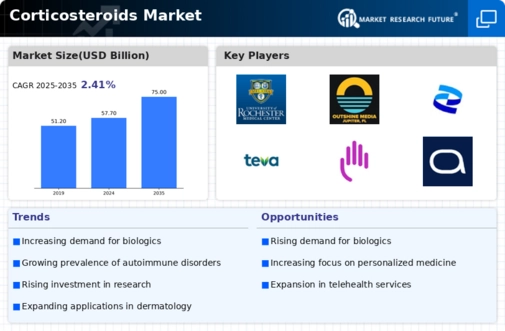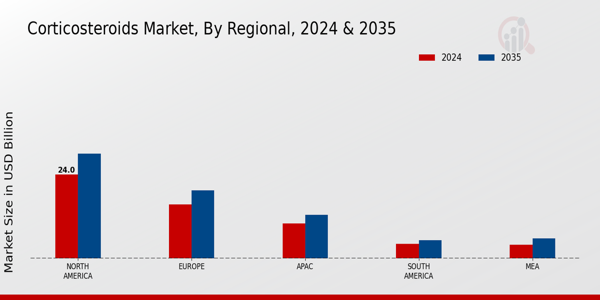Rising Geriatric Population
The aging population is a significant factor contributing to the growth of the Corticosteroids Market. Older adults are more susceptible to chronic diseases that require corticosteroid treatment, such as arthritis and respiratory disorders. As the geriatric demographic continues to expand, the demand for corticosteroids is expected to increase correspondingly. This demographic shift presents both challenges and opportunities for the market, as healthcare systems must adapt to meet the needs of an aging population. Consequently, the corticosteroid market is poised for growth, driven by the necessity to manage age-related health issues effectively.
Growing Awareness and Education
There is a notable increase in awareness and education regarding the benefits and risks associated with corticosteroid use, which is positively impacting the Corticosteroids Market. Healthcare professionals and patients are becoming more informed about the therapeutic advantages of corticosteroids in managing various conditions. This heightened awareness is leading to more prescriptions and a broader acceptance of corticosteroid therapies. Furthermore, educational initiatives aimed at demystifying corticosteroid use are likely to foster a more favorable perception, thus driving market growth. As patients become more proactive in managing their health, the demand for corticosteroids is expected to rise.
Regulatory Support and Approvals
Regulatory bodies are increasingly providing support for the development and approval of corticosteroid medications, which is a crucial driver for the Corticosteroids Market. Streamlined approval processes and favorable regulatory frameworks encourage pharmaceutical companies to invest in corticosteroid research and development. This regulatory environment not only facilitates the introduction of new corticosteroid products but also enhances market competition. As a result, patients gain access to a wider array of treatment options, which can lead to increased market penetration. The ongoing collaboration between regulatory agencies and the pharmaceutical industry is likely to sustain this positive trend.
Advancements in Drug Formulations
Innovations in drug formulations are significantly influencing the Corticosteroids Market. The development of novel delivery systems, such as inhalers and transdermal patches, enhances the efficacy and patient compliance of corticosteroid therapies. These advancements not only improve the therapeutic outcomes but also expand the range of applications for corticosteroids. For instance, the introduction of long-acting formulations has been shown to provide sustained relief for chronic conditions, thereby increasing their market share. As pharmaceutical companies continue to invest in research and development, the market is likely to witness a surge in new corticosteroid products.
Increasing Prevalence of Chronic Diseases
The rising incidence of chronic diseases such as asthma, rheumatoid arthritis, and inflammatory bowel disease is a primary driver of the Corticosteroids Market. As these conditions become more prevalent, the demand for effective treatment options escalates. Corticosteroids are often prescribed to manage inflammation and suppress the immune response, making them a cornerstone in the therapeutic arsenal against these ailments. According to recent estimates, the prevalence of asthma alone affects millions, leading to a substantial market for corticosteroid medications. This trend indicates a growing reliance on corticosteroids, thereby propelling the market forward.


















Leave a Comment